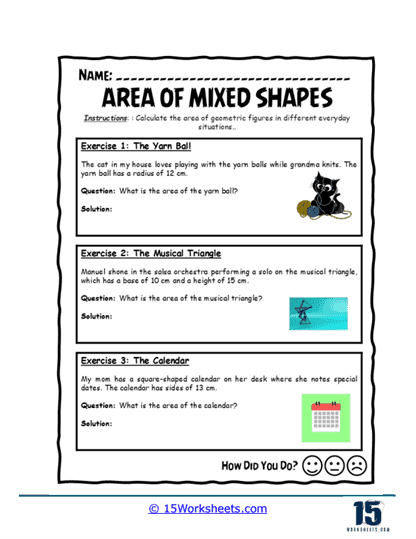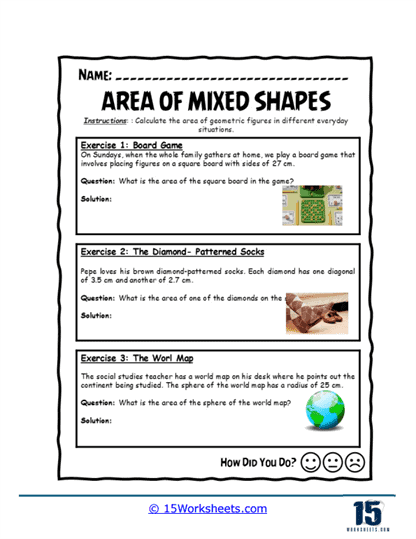Area of Mixed Shapes Worksheets
About Our Area of Mixed Shapes Worksheets
Understanding the area of different geometric shapes is a fundamental math skill that extends far beyond the classroom. This collection of printable worksheets is carefully designed to provide students with a hands-on learning experience, making geometry not only accessible but also practical and engaging.
By working through structured exercises, students will explore triangles, squares, rhombuses, and circles while encountering real-life applications such as traffic cones, playing cards, and house layouts. These relatable scenarios help students make meaningful connections between abstract mathematical concepts and their everyday environment.
With each worksheet, students develop a deeper understanding of area calculation and spatial reasoning, skills essential for a wide range of disciplines including engineering, architecture, design, and urban planning. By engaging in these exercises, students build confidence in their mathematical abilities and sharpen their problem-solving skills-key competencies that will serve them in both academics and life.
Many math worksheets focus solely on computation, but this collection takes a conceptual and applied approach, encouraging students to see the why and how behind the numbers. These worksheets ensure that students are not just memorizing formulas, but truly understanding the process of calculating area and its significance.
Key Features
Diverse Geometry Problems – These worksheets feature a comprehensive selection of geometry exercises that challenge students to calculate the area of triangles, squares, rhombuses, and circles. Instead of a single repetitive problem type, students will engage with varied question formats, including direct calculations, word problems, and real-world applications. This diverse approach ensures that learners build a well-rounded understanding of area formulas and develop confidence in working with different shapes.
Real-Life Applications – Mathematics is most effective when students can connect it to real-world situations, and these worksheets excel at bridging the gap between abstract concepts and everyday life. By incorporating familiar objects like traffic cones, playing cards, and houses, students see how area calculations influence everything from city planning to home design. This contextual learning approach fosters a deeper appreciation for geometry and highlights its importance in careers such as architecture, engineering, and interior design.
Step-by-Step Problem-Solving – Each worksheet is designed to promote logical reasoning by breaking down the problem-solving process into manageable steps. Students begin by identifying key dimensions, applying the correct formulas, and working through the calculations systematically. This structured approach not only enhances problem-solving skills but also reinforces mathematical discipline and builds computational accuracy, which are essential for more advanced math courses.
Engaging Visuals & Interactive Elements – Learning is more effective when it’s visually stimulating, and these worksheets incorporate fun illustrations and interactive elements to keep students engaged. Whether it’s a brightly colored traffic cone, a neatly outlined playing card, or a well-drawn rhombus representing a house, these images help clarify concepts and make geometry more approachable. The use of diagrams encourages visual learners to better understand how different shapes are structured and how their areas are calculated.
Comparison & Analytical Skills – Beyond simple calculations, some exercises challenge students to compare the area of different geometric shapes and determine which has the largest surface. This analytical component requires students to think critically about the relationships between different shapes, rather than just applying formulas mechanically. By engaging in comparison-based exercises, students develop the ability to assess proportions, scale, and spatial reasoning, all of which are crucial for higher-level math and science courses.
Skills Developed
Understanding and Applying Area Formulas – Mastery of geometry starts with knowing the right formulas and understanding when to use them. These worksheets guide students through the process of correctly identifying which formula applies to triangles, squares, rhombuses, and circles, helping them build a strong mathematical foundation. As they work through problems, students become more comfortable recognizing patterns in geometry, making it easier for them to recall and apply formulas in various contexts.
Problem-Solving & Logical Thinking – The step-by-step nature of these worksheets encourages students to develop structured problem-solving techniques. Instead of just plugging numbers into equations, students are prompted to think critically about the problem, analyze given information, and determine the most efficient way to solve it. This strengthens their logical reasoning skills, which are not only essential for mathematics but also applicable in fields like computer science, physics, and economics.
Real-World Application – Learning geometry is not just about passing a test; it’s about understanding how math operates in the world around us. These worksheets emphasize practical applications by linking area calculations to real-life situations, such as determining the space needed for tiling a floor, painting a wall, or cutting materials for a project. By practicing these real-world scenarios, students gain valuable skills that they can carry into future careers in engineering, construction, landscaping, and design.
Comparative Analysis – Understanding how shapes compare to one another in terms of area is an essential skill for measurement and estimation. These worksheets help students develop comparative analysis skills by having them assess which shapes occupy more space and how different dimensions affect area. Whether they are estimating the size of a garden, comparing fabric for sewing, or analyzing blueprints for a home, this skill has numerous practical applications in both academic and everyday settings.
Mastering the area of mixed shapes is a key math skill that connects directly to real-world applications. This worksheet collection goes beyond textbook learning by providing engaging exercises that help students visualize and apply geometric concepts in meaningful ways.
With structured practice, real-world examples, and interactive elements, these worksheets make learning fun, practical, and effective. Whether used in the classroom, at home, or for independent study, they provide a well-rounded, engaging experience that fosters mathematical confidence and critical thinking.















